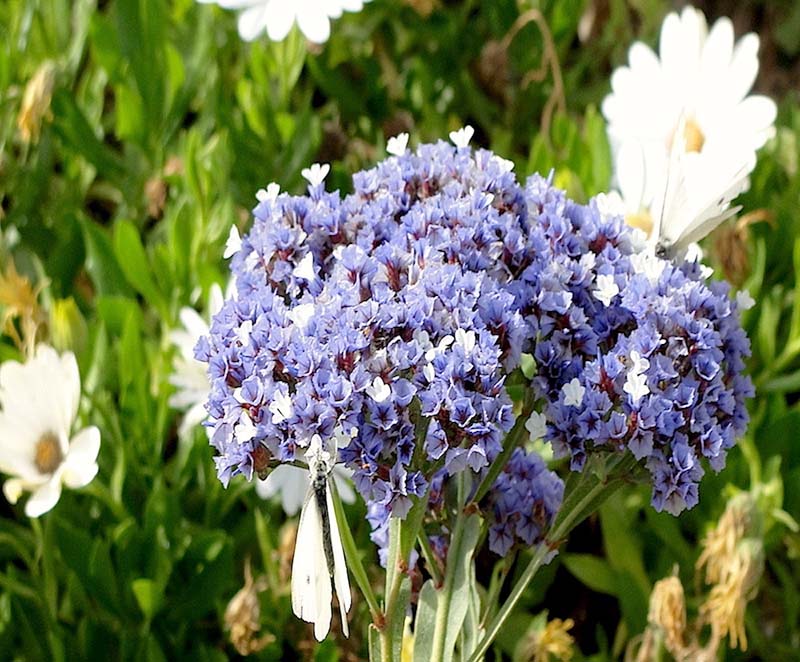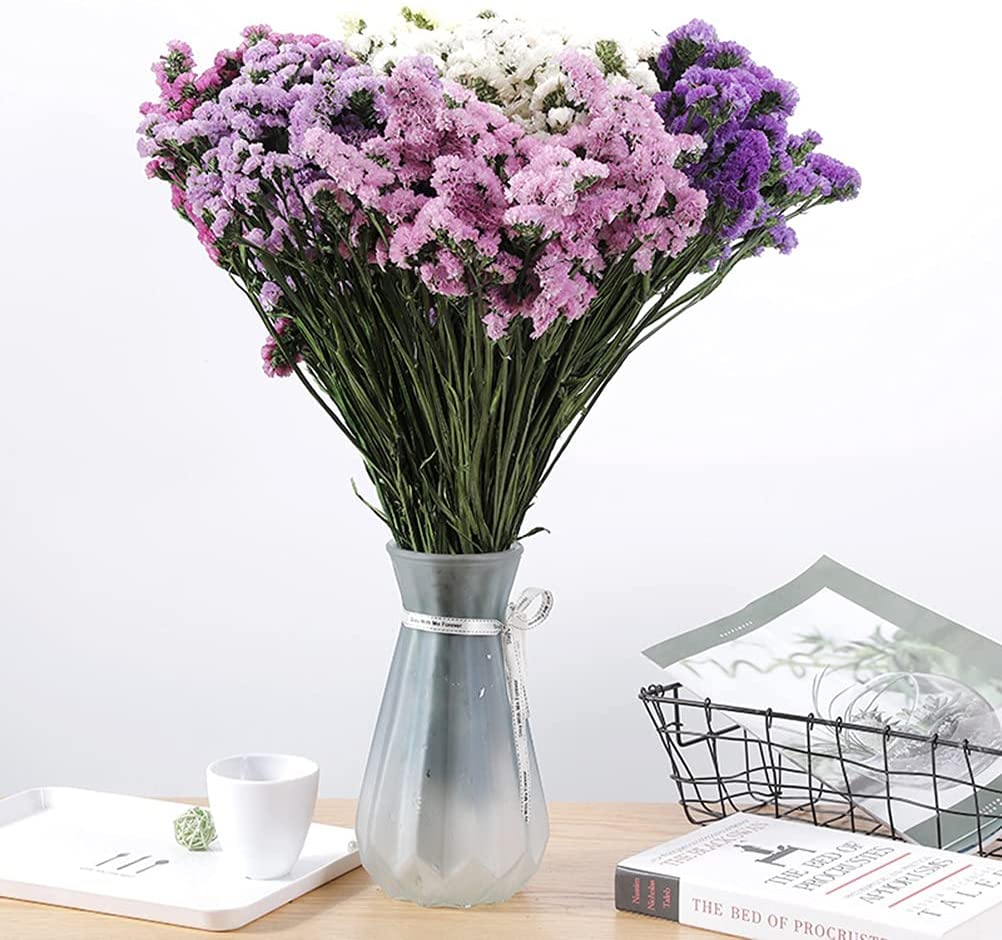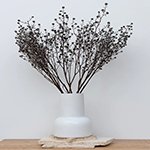Sea lavender flower specifications
- Scientific name : Limonium
- Family : Plumbaginaceae
- Order : Caryophyllales
- Genus : Limonium
- Native Area : Coastal areas
Sea Lavender : Also known as marsh rosemary and lavender thrift, sea lavender is a perennial coastal plant that can often be found growing in both salt marshes and along coastal sand dunes. Despite its name, it is not actually related to the lavender plant.
The plant creates leathery, spoon-shaped leaves, red-tinted stems, and delicate purple blooms that appear in summer. These plants are easily recognizable as a result of their dense, cloud-like sprays of tiny, paper-like lavender flowers.
read more : Everything about chamomile plant : How to Plant & care for them

Sea lavender is primarily grown for its beautiful floral display; though its large green paddle-shaped basal rosette leaves will also create an attractive ground-cover in the early spring, until the plant flowers in the summer. Part of what makes sea lavender a somewhat unusual perennial is that the leaves are so close to the ground, and long flower stems will develop from this grouping of foliage.
That’s part of what makes these plants an ideal choice to plant among other similar perennials—the foliage remains mostly hidden, and the flowers stand out. They are also lovely as a stand-alone plant, particularly for anyone who is looking for a soft, yet eye-catching, texture around the bordering edge of a garden.
Distribution
The genus has a subcosmopolitan distribution in Europe, Asia, Africa, Australia and North America. By far the greatest diversity (over 100 species) is in the area stretching from the Canary Islands east through the Mediterranean region to central Asia; for comparison, North America only has three native Limonium species.
read more : Everything about lavender flower : How to Plant & care for them
Types of sea lavendef species
There are between 120-150 species in the genus, many of them local endemic species with a very restricted range. Species not given a common name here are generally referred to simply as “sea-lavender”, “statice,” or “marsh-rosemary”.
- Limonium aragonense (Monegros, endemic)
- Limonium arboreum (tree limonium or Statice arborca; Tenerife, endemic)
- Limonium aureum (central Asia: Siberia, Mongolia, northwest China)
- Limonium auriculaeursifolium (Alderney sea-lavender; southwest Europe, northwest Africa)
- Limonium australe (Australia)
- Limonium bellidifolium (matted sea-lavender; Europe, southwest Asia)
- Limonium bicolor (Mongolia, northwest China)
- Limonium binervosum (rock sea-lavender; western Europe)
- Limonium bourgaei (Lanzarote, endemic)
- Limonium brassicifolium (Canary Islands, Statice brassicifolia)
- Limonium braunii (Cape Verde)
- Limonium brunneri (Cape Verde)
- Limonium caesium (western Mediterranean)
- Limonium californicum (California sea-lavender; western North America, Oregon to Baja California)
- Limonium callianthum (western China: Xinjiang)
- Limonium cancelatum (eastern Mediterranean Croatia)
- Limonium carolinianum (Carolina sea-lavender; eastern North America, Newfoundland to Bermuda,
- Florida and Tamaulipas; syn. L. angustatum, L. nashii)
- Limonium caspium (central Europe east to central Asia)
- Limonium chrysocomum (central Asia)
- Limonium confusum (western Mediterranean)
- Limonium congestum (central Asia)
- Limonium coralloides (central Asia)
- Limonium cordatum (central Mediterranean)
- Limonium cosyrense (eastern Mediterranean)
- Limonium delicatulum (western Mediterranean)
- Limonium dichroanthum (central Asia)
- Limonium dielsianum (western China: Gansu, Qinghai)
- Limonium dregeanum (Natal statice; South Africa)
- Limonium echioides (Mediterranean)
- Limonium emarginatum (southern Iberia, northern Morocco)
- Limonium ferulaceum (western Mediterranean)
- Limonium flexuosum (central Asia)
- Limonium franchetii (east coastal China)
- Limonium fruticans (Tenerife, endemic)
- Limonium gmelinii (eastern Europe, northern Asia, Siberia)
- Limonium gougetianum (western Mediterranean)
- Limonium humile (lax-flowered sea-lavender; northwest Europe)
- Limonium imbricatum (Tenerife, endemic)
- Limonium insigne (southeast Spain, endemic)
- Limonium jovibarba (Cape Verde)
- Limonium kaschgaricum (central Asia)
- Limonium iranicum (Iran)[3]
- Limonium lacostei (western China, Tibet, Kashmir)
- Limonium leptolobum (central Asia)
- Limonium leptostachyum (statice; central Asia)
- Limonium lilacinum (central Turkey, endemic)
- Limonium limbatum (Transpecos sea-lavender; interior southwest United States)
- Limonium lobinii (Cape Verde)
- Limonium macrophyllum (Tenerife)
- Limonium scabrum
- Limonium macrophyllum
- Limonium macropterum (Canary Islands)
- Limonium macrorhabdos (Ladakh)
- Limonium melitensis (Malta)
- Limonium minutum (southeast France, endemic)
- Limonium mouretii (Morocco)
- Limonium multiflorum (western Portugal, endemic)
- Limonium myrianthum (central Asia)
- Limonium narbonense (Southern Europe, North Africa, Southwest Asia)
- Limonium nashii (Maritime North America)
- Limonium ornatum (Morocco)
- Limonium otolepis (Saltmarsh sea-lavender; southwest and central Asia)
- Limonium paradoxum (Great Britain, Ireland,[4] endemic)
- Limonium paulayanum (Yemen, endemic)
- Limonium pectinatum (Canary Islands)
- Limonium peregrinum (South Africa)
- Limonium perezii (Perez’s sea-lavender; Canary Islands)
- Limonium platyphyllum (German statice; central and southeast Europe)
- Limonium potaninii (western China: Sichuan, Qinghai, Gansu)
- Limonium preauxii (Canary Islands)
- Limonium puberulum (Canary Islands)
- Limonium ramosissimum (Mediterranean)
- Limonium reniforme (kidneyleaf sea-lavender; Iran)
- Limonium rezniczenkoanum (central Asia)
- Limonium scabrum Kuntze (South Africa)
- Limonium sieberi (eastern Mediterranean)
- Limonium sinense (eastern Asia coasts: China, Ryukyu Islands, Vietnam)
- Limonium sinuatum (wavyleaf sea-lavender; Mediterranean)
- Limonium sokotranum (Yemen, endemic)
- Limonium solanderi (Australia)
- Limonium spathulatum (Mediterranean)
- Limonium spectabile (Canary islands)
- Limonium strictissimum (Mediterranean: France, Italy)
- Limonium suffruticosum (western and central Asia)
- Limonium tenellum (Mongolia, northwest China)
- Limonium tetragonum (autumn statice or square-stem statice; eastern Asia south to New Caledonia)
- Limonium thouinii (Mediterranean)
- Limonium tomentellum (Black Sea region)
- Limonium virgatum (western Mediterranean)
- Limonium vulgare (common sea-lavender; western Europe, northwest Africa)
- Limonium wrightii (Japan, Taiwan)
- Limonium zeraphae (Malta)
read more : Everything about aster flower : How to Plant & care for them
How to Grow Sea Lavender Plants
Sea lavender is an ideal choice for gardeners who want to create bold, lasting color in hot or dry climates. They are a great addition to beds, borders, and cutting gardens, as well as for larger patio containers and fresh or dried arrangements.
Better yet, sea lavender is a fairly easy perennial to cultivate and has very few cultural needs. It can be divided every two or three years (always in early spring), but be sure to dig deeply to prevent damage to its long roots. Sea lavender is often considered difficult to divide, and taller plants may require stakes in order to remain upright.
These plants attract pollinators including bees and butterflies. Though they are considered virtually pest- and disease-free, some of the issues these plants could be susceptible to are: rust, leaf and flower spots, gray mold, crown rot, and Southern blight. The flowers will typically turn brown in the winter months.
-
Light
Sea lavender will grow best when planted in full sun, as it will encourage the largest amount of densely grown flowers. Additionally, planting in full sun will also help to ensure the plant stays dry, which can help prevent root rot.
-
Water
You’ll want to water newly-planted sea lavender regularly in order to establish a deep and healthy root system. However, once the plant is established, it will only require occasional watering. Sea lavender is a drought-tolerant plant.
read more : Everything about yarrow flower : How to Plant & care for them
-
Soil
Sea lavender thrives in sandy soil, but will tolerate average, well-drained soil.
-
Temperature and Humidity
A warm-weather plant, Sea lavender will flower throughout the summer, but reaches peak flowering around August and September. As a coastal perennial, it will grow well in salty, sandy, and windy conditions.
-
Fertilizer
Take care when using fertilizer with sea lavender, as fertilizing too heavily may cause it to grow excess foliage and never actually flower. It can also kill these plants. When looking for fertilizer, steer clear of varieties that are rich in nitrogen.
Export of Iran dried sea lavender flower
Sea lavender flower is one of Iran’s export goods and has provided a great opportunity for Iranian traders to bring a lot of currency to the country by exporting dried sea lavender flower . Both types of sea lavender flower products can be exported either as fresh cut flowers or as dried flowers because each has its own customer.
The export of dried sea lavender flower has provided a great opportunity for wholesalers and exporters of dried sea lavender flower and other plants to make significant profits.
read more : Drying natural flowers | Introducing 8 wonderful ways to dry flowers

Propagating Sea Lavender
In order to propagate sea lavender, you’ll want to first sow the seeds in indoor containers before dividing in the spring. Seeding is the easy way to propagate these perennials.
Pruning
Though they don’t require a great deal of pruning, you can cut sea lavender back after flowering. Removing dead leaves will make room for new growth in the spring.
Notice : this article has been translated by google translate , if you have any questions or need more information Please contact us by writing a comment on this page.



0 Comments